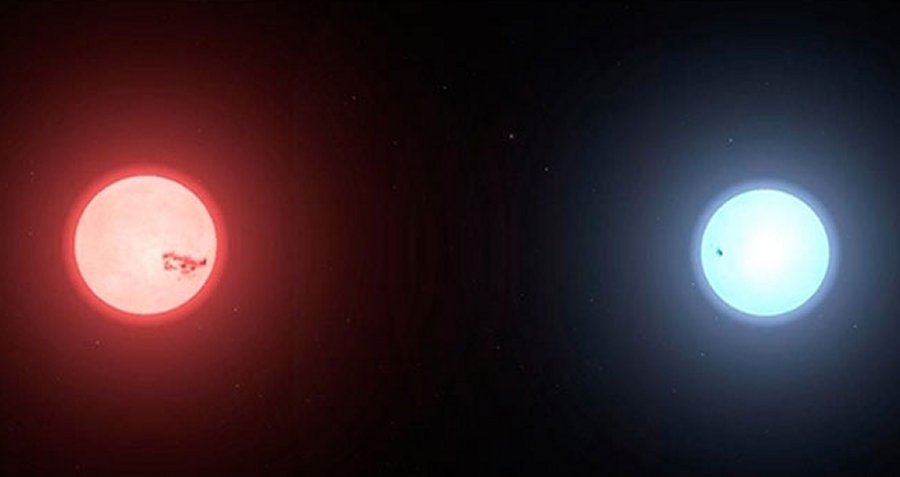Stellar Sibling Responsible For Transformation Of Its Companion To A White Dwarf
Star can be reduced to white dwarf status by its companion, according to a series of observations conducted by Brazilian astronomers between 2005 and 2013.
Reserchers studied a pair of celestial objects rarely seen in the Milky Way: a very low-mass white dwarf and a brown dwarf.
This binary system HS 2231+2441, astronomers say, is very unique. The white dwarf’s existence was prematurely cut off by its companion, a brown dwarf, which caused its early death through “malnutrition” or loss of matter.

In this case, the white dwarf’s mass is between two and three-tenths of the Sun’s mass. Its surface temperature is 28,500 Kelvin (K). The brown dwarf’s mass is roughly 34-46 times that of Jupiter, the largest planet in the Solar System. Both of them are located in the constellation Perseus and form the least massive binary system ever identified.
“This type of low-mass binary is relatively rare. Only a few dozen have been observed to date,” said Leonardo Andrade de Almeida, first author of the study. Almeida is a postdoctoral fellow at the University of São Paulo’s Institute of Astronomy, Geophysics & Atmospheric Sciences (IAG-USP).
A white dwarf – once a normal star – is the endpoint of the evolution of an intermediate- or low-mass star, with a mass between 0.5 and 8 times that of our Sun. A brown dwarf is a substellar object with mass intermediate between those of a star and a planet.
In this case, the white dwarf’s mass is between two and three-tenths of the Sun’s mass. Its surface temperature is 28,500 Kelvin (K). The brown dwarf’s mass is roughly 34-46 times that of Jupiter, the largest planet in the Solar System. Both of them are located in the constellation Perseus and form the least massive binary system ever identified.
Binary system with white dwarf and brown dwarf
The white dwarf was once a normal star and even more massive than its companion, it evolved faster, creating a helium core as it burned hydrogen. Given the rapid rate at which it burned hydrogen in the layer that encircled the helium core, it was on its way to becoming a red giant, the usual destiny of Sun-like stars, and its radius may have exceeded 150 million km, the distance from Earth to the Sun.
With this huge amount of energy, it began interacting gravitationally and transferring mass to its companion.
“This transfer of mass from the more massive star, the primary object, to its companion, which is the secondary object, was extremely violent and unstable, and it lasted a short time,” Almeida explained in a press release.
According to Almeida, the discovery of this binary system, comprising an object with an exposed core orbiting a cold object with a short orbital period of approximately three hours, may contribute to a better understanding of the creation of hot, compact objects like low-mass white dwarfs, which were discovered relatively recently.
This class of dead objects can be formed only in binary systems, considering the age of the Universe.
“Binary systems offer a direct way of measuring the main parameter of a star, which is its mass,” Almeida said.
About 50% of the low-mass stars in the Milky Way are binary systems. Among high-mass stars, the proportion is almost 100%, and 75% will interact in some way, such as matter exchange, accelerating rotation of components, and mergers.
“That’s why binary systems are crucial to our understanding of the life cycle of stars,” Almeida said.
The findings are published in the Monthly Notice of the Royal Astronomical Society.



 Creators of mankind
Creators of mankind Description of “Tall white aliens”
Description of “Tall white aliens” Where they came from?
Where they came from? About hostile civilizations
About hostile civilizations The war for the Earth
The war for the Earth “Tall white aliens” about eternal life
“Tall white aliens” about eternal life Video: “Nordic aliens”
Video: “Nordic aliens” Aliens
Aliens Alien encounters
Alien encounters The aliens base
The aliens base UFO
UFO Technology UFO
Technology UFO Underground civilization
Underground civilization Ancient alien artifacts
Ancient alien artifacts Military and UFO
Military and UFO Mysteries and hypotheses
Mysteries and hypotheses Scientific facts
Scientific facts


















